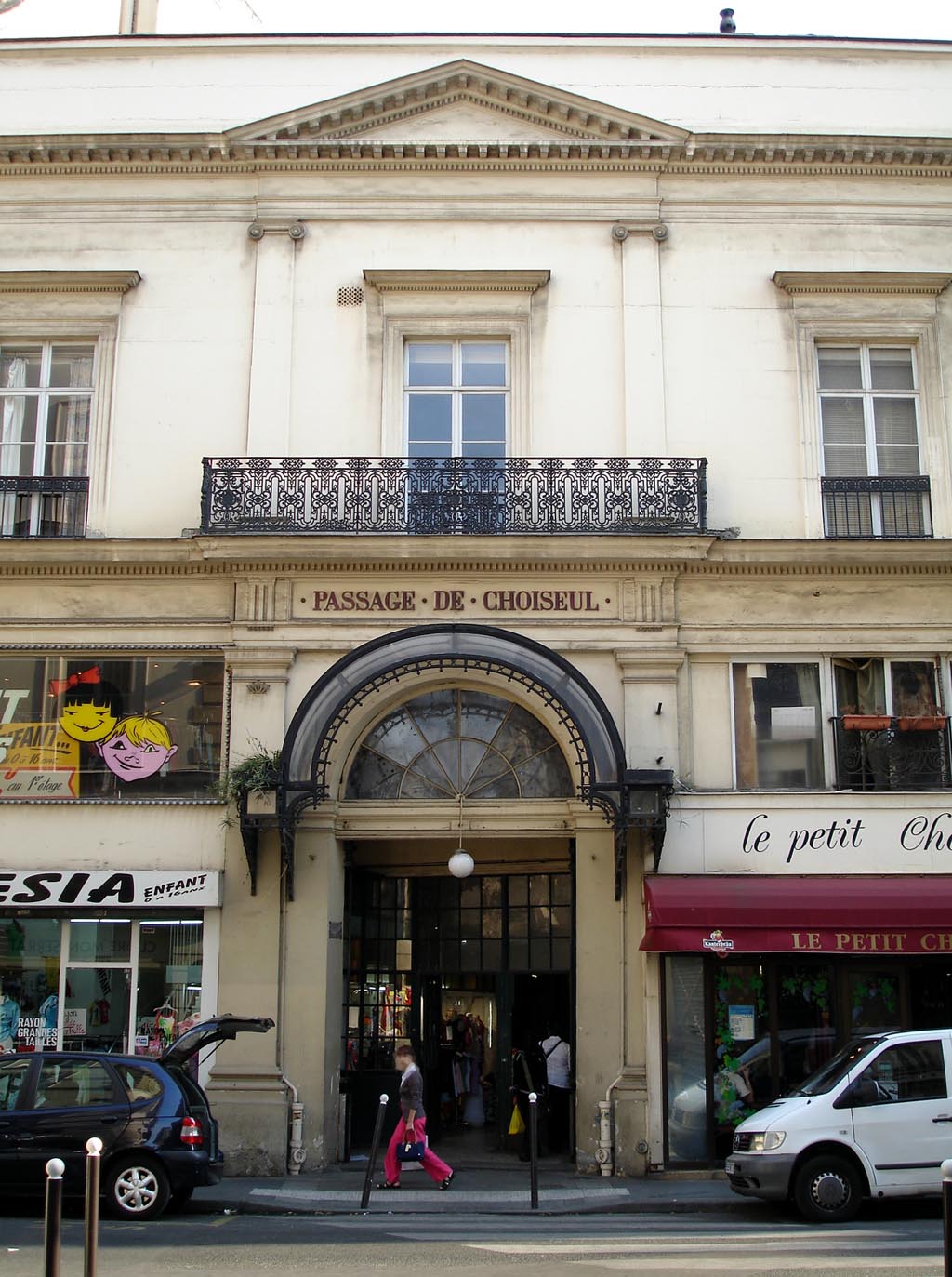Passage Choiseul on:
[Wikipedia]
[Google]
[Amazon]
 Passage Choiseul is one of the
Passage Choiseul is one of the
 Passage Choiseul is one of the
Passage Choiseul is one of the covered passages of Paris The covered passages of Paris (french: Passages couverts de Paris) are an early form of shopping arcade built in Paris, France primarily during the first half of the 19th century. By the 1867 there were approximately 183 covered passages in Paris bu ...
, France
France (), officially the French Republic ( ), is a country primarily located in Western Europe. It also comprises of Overseas France, overseas regions and territories in the Americas and the Atlantic Ocean, Atlantic, Pacific Ocean, Pac ...
located in the 2nd arrondissement. It is the continuation of Rue de Choiseul.
History
The Passage Choiseul is on a site previously occupied by four '' hôtels particuliers'', acquired by the for a real-estate development that included theOpéra-Comique
The Opéra-Comique is a Paris opera company which was founded around 1714 by some of the popular theatres of the Parisian fairs. In 1762 the company was merged with – and for a time took the name of – its chief rival, the Comédie-Italienne ...
's nearby Salle Ventadour
The Salle Ventadour, a former Parisian theatre in the rue Neuve-Ventadour, now the rue Méhul (2nd arrondissement of Paris), was built between 1826 and 1829 for the Opéra-Comique, to designs by Jacques-Marie Huvé, a prominent architect. The ori ...
.Poisson, Michel (1999). ''Paris: Buildings and Monuments''. New York: Harry N. Abrams, p. 64. . The passage was built between 1826 and 1827, first to the designs of the architect , then Antoine Tavernier. Mazois died before the building was complete, and Tavernier completed the work.
The author Louis-Ferdinand Céline
Louis Ferdinand Auguste Destouches (27 May 1894 – 1 July 1961), better known by the pen name Louis-Ferdinand Céline ( , ) was a French novelist, polemicist and physician. His first novel ''Journey to the End of the Night'' (1932) won the ''Pri ...
lived here as a child in the early 20th century. The Passage Choiseul is mentioned in two of his novels: ''Journey to the End of the Night
''Journey to the End of the Night'' (french: Voyage au bout de la nuit, 1932) is the first novel by Louis-Ferdinand Céline. This semi-autobiographical work follows the adventures of Ferdinand Bardamu in the World War I, colonial Africa, the Un ...
'' and ''Death on the Installment Plan
''Death on Credit'' (french: link=no, Mort à crédit, US translation: ''Death on the Installment Plan'') is a novel by author Louis-Ferdinand Céline, published in 1936. The most common, and generally most respected English translation is Ralph ...
''. Céline described it as having gas lamp
Gas lighting is the production of artificial light from combustion of a gaseous fuel, such as hydrogen, methane, carbon monoxide, propane, butane, acetylene, ethylene, coal gas (town gas) or natural gas. The light is produced either directly ...
s that "stank as badly as the stagnant air", and the aroma of "dogs urine" in the passage.
In 1907 the glass roof was replaced (although its ironwork dates from 1891Ayers, Andrew (2004). ''The Architecture of Paris''. Paris: Axel Menges, p. 387. .). The passage later fell into disrepair. In the 1970s visitation increased when Kenzo
is a common masculine Japanese given name.
Possible writings
Kenzō can be written using different kanji characters and can mean:
*賢三, "wise, three"
*健三, "healthy, three"
*謙三, "humble, three"
*健想, "healthy, concept"
*建造, "bu ...
opened a boutique in the passage. They have since relocated to the Place des Victoires
The Place des Victoires is a circular ''place'' in Paris, located a short distance northeast from the Palais Royal and straddling the border between the 1st and the 2nd arrondissements. The Place des Victoires is at the confluence of six streets ...
.
Today
Passage Choiseul is a shopping and food area. It has restaurants, clothing stores, book stores, jewellery shops, art galleries, art supply shops and a hair stylist. The entrance to theThéâtre des Bouffes-Parisiens
The Théâtre des Bouffes-Parisiens () is a Parisian theatre founded in 1855 by the composer Jacques Offenbach for the performance of opéra bouffe and operetta. The current theatre is located in the 2nd arrondissement at 4 rue Monsigny with an ...
is located in the passage. The ground floor is mainly retail and the upper floors are primarily residential. It is the longest covered passage in the city, at 190 meters long and 3.7 meters wide. In 2012, renovations and restoration were begun under Jean Frédéric Grevet. It is a registered historic monument
A monument is a type of structure that was explicitly created to commemorate a person or event, or which has become relevant to a social group as a part of their remembrance of historic times or cultural heritage, due to its artistic, hist ...
in France.
Location
It is just west ofGalerie Vivienne
The Galerie Vivienne is one of the covered passages of Paris, France, located in the 2nd arrondissement. It is long and wide. The gallery has been registered as a historical monument since 7 July 1974.
History
The gallery was built in 1823 b ...
on Rue des Petits-Champs
Rue des Petits-Champs is a street which runs through the 1st and 2nd arrondissement of Paris, France.
Location
This one-way street, running east-west, is located between rue de la Banque and Avenue de l'Opera.
History
It was officially crea ...
in the 2nd arrondissement.
References
{{coord, 48, 52, 08, N, 2, 20, 09, E, region:FR-75_type:landmark_source:kolossus-dewiki, display=title Tourist attractions in Paris Infrastructure completed in 1827 Buildings and structures in the 2nd arrondissement of Paris Covered passages of Paris 1827 establishments in France